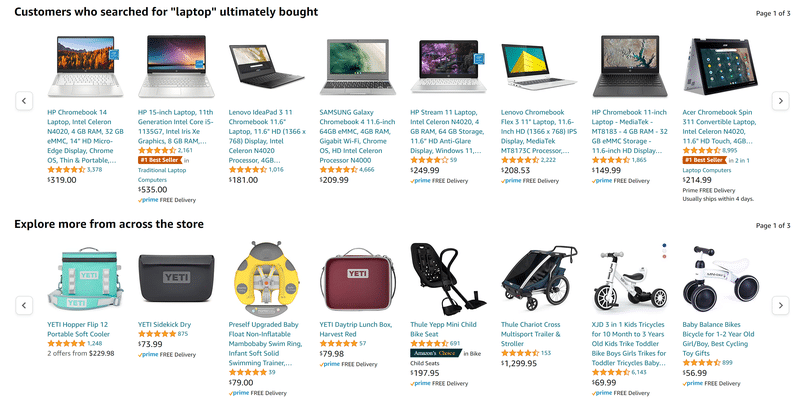This article will look at what intent-based marketing is and why many consider it the future of marketing. The text will explore how intent-based marketing has the potential to be one of the most significant changes in our industry in recent years.
Companies are still trying to understand the best ways to reach their customers in today’s marketing world. Changes with increased privacy and the possibility of cookies suppression will probably turn intent-based marketing mixed with contextual targeting into a good solution.
The intent-based marketing approach helps businesses track how consumers react and motivate them to improve engagement with their products or services. Before diving into the details, let’s have an overview of Intent-Based Marketing.
What is Intent-Based Marketing?
Intent marketing means commercializing a product/service by analyzing consumers’ intent to purchase or use that product that may have been communicated explicitly or not by the subscriber.
It is a way to reach and influence your customer based on intent and what they want or need at a specific moment.
It looks beyond traditional customer behavior, which often relies on complex data about what customers are doing to their business model. It instead focuses on intent – what people want to do and how they behave.
Extensively used in SEM.
Intent-based marketing, also known as intent marketing, is incredibly well known in SEM, Search Engine Marketing, or SEO – Search Engine Optimization because the searcher is intended to find or understand something and uses keywords to find out what they want. The companies then target these keywords to show the searcher’s interest or intent.
The key to this new approach is understanding why consumers buy certain products and services. This type of marketing will give you more relevant information about your audience, providing them with better products and services.
The idea has been used for a long time
This idea is not new. For instance, companies like HP, PepsiCo, Coca-Cola have used this approach for quite a long time. Soft drink giants PepsiCo and Coca-Cola are well-known for using gamification to engage their customers through different campaigns. These campaigns are serious business because they target people who want the things they sell.
E-commerces have been using it to make suggestions based on previous purchases or browse behavior. SaaS companies have been using to retarget customers that visited their websites and didn’t conclude a purchase.

Marketers are getting more aware that consumers are willing to pay attention to brands that make them happy.
This principle has become more critical in the last few years because consumers are more demanding and have less time than ever before. They need to be convinced that they value their money by purchasing a brand’s product instead of the competitor’s. Also, they need to find the product quickly and even get AI to help them decide.
How Does Intent-Based Marketing Work?
Many companies like to segment their consumers by demographics to reach their customers successfully. They typically include age, gender, location, educational attainment, and more.
Intent-based marketing takes a different approach. Knowing the general information about a customer helps understand their needs and wants in a particular category or product– but it’s not only that. Intent-based marketing uses a variety of other tools.
One example of these tools is predictive analytics. Data from existing customers are used to develop a predictive model for future customers based on their online actions and search history.
It is done by analyzing specific keywords and phrases. The analysis looks at the intent behind the words rather than just the word itself. The goal is to find what motivates the consumer and what they’re looking for when using these words.
The Future of Intent-Based Marketing
The key to successful intent-based marketing is getting a clear understanding of what motivates a consumer. The most important thing to remember is that consumers won’t necessarily tell you what they want – they’re going to show you.
When using predictive analytics, businesses can transform their existing data into actionable insight that predicts a consumer’s behavior and likely future purchase decisions. This allows companies to create highly personalized experiences for their customers.
For example, a customer may be searching for a specific flavor of crackers, but they don’t know it. When this company’s AI analyzes their behavior, either by searching or browsing, it uses this information to determine which flavors the consumer is interested in and what they’re searching for. It analyzes what similar customers interested in this flavor also searched for or purchased. Then it offers other products that this customer needs, besides laser-targeting his needs.

Intent-based marketing is another way businesses can better understand their customers. The future of intent-based marketing is already in progress. Companies are taking the guesswork out of their marketing efforts by making data their guide.
Why is Intent-Based Marketing Called the Future of Marketing?
Let’s discuss the topic point by point.
1) It Improve Marketing Efforts
Intent-based marketing is a strategy used to improve your business’s marketing efforts. It’s a trend that will only continue to grow, and it uses data and predictive analytics to help you understand consumers and their motivations.
It helps businesses and brands implement more personalized customer experiences within their offerings. Companies can create more effective campaigns and achieve higher customer retention rates by using these tools.
2) Improves Engagement with Predictive Analytics
Businesses and brands can ultimately improve consumer engagement by using predictive analytics and modeling. This way, your business can provide products and services that your customers want – and will use – instead of just throwing additional “me-too” products on the market hoping for a sale.
3) It Offers a More Customized Experience
The future of intent-based marketing is already here. Bringing consumers more personalized experiences is likely to become an even bigger priority for businesses worldwide as the years go on. As technology advances, the tools available to help companies put this concept into practice.
4) Engage With Customers Based on What They Need
As consumers increasingly search for highly personalized content, businesses look for new ways to engage with them. Intent-based marketing is an incredibly effective way to do that. Companies can understand precisely what their customers want and give them what they need through technology.
While it may seem like a disadvantage right now, the progress of predictive analytics is likely to benefit businesses in the future and provide better insights into consumers’ needs and wants.
5) 24 x 7 Internet Consumption
With the rise of mobile and social, data has been captured everywhere at any time. As consumers become more interconnected through these platforms, the use of the Internet increases at an exponential rate, and intent-based marketing becomes even more critical for industries all over the world to attend to consumer needs while they’re online.

6) Easy To Understand International Customer Needs
The Internet has provided global businesses with incredible opportunities to reach their customers and give them exactly what they want and need instead of throwing out products and services hoping for a sale.
The need to profoundly understand a foreign country’s culture becomes secondary if you have an AI supporting your website sales.
7. Align Budget Strategies With Consumer Interests
Intent-based marketing will become increasingly important as more marketers and brands align their budget and advertising strategies with consumers’ interests. As more service-oriented industries take the plunge into this trend, we’re likely to see a lot of progress over the next few years.
8) With Intent Marketing And Use of Predictive Analytics, It’s Easier to Identify Customer Needs
The use of intent-based marketing is all about understanding what motivates consumers. These days, that’s easier than ever to do with the help of technology and data mining. For example, if your business asks customers what they want in your categories, they probably won’t tell you directly.
Instead, they’ll give you clues in the form of search phrases. With predictive analytics, you can analyze this information to understand their needs and help them reach their goals.
Through the use of predictive analytics, your business can find patterns in consumer data and predict what they’ll do next. It allows you to use this information to analyze how they think and why they’re searching. Using these insights, marketers can then implement campaigns to help them reach their goals.
9) Enhances Buyer’ Purchase Experience
The future of intent-based marketing will likely be even more personalized marketing experiences for customers everywhere. The incompatibility of information between buyers and sellers makes the purchase experience complex for customers. Intent data is used to anticipate providing answers to their questions.

Whether your business offers products or services, the end goal is to help people achieve their goals and needs more efficiently than ever before.
10) Increases the Quantity and Quality of Behavioral Data
Monitoring each visitor on the website offers specific information about user activities, including time on the page, clicks, conversions, page scrolls, and hovers. The data is in-depth to understand the intent at the moment of the visit.
11) Connet With Customer More Profoundly
Digitally-focused customers today are expecting more from the companies they interact with, which is a trend that’s likely to continue. In addition to targeting customers based on their interests and goals, businesses are beginning to use data and technology to help them connect with these customers more profoundly.
The future of intent-based marketing will be about understanding your consumers’ needs and what satisfies them. If you can learn more about individual customers, whether they’re B2B or B2C customers, you can use this information to give your business a competitive advantage.
Types of Intent-Based Marketing Activities
Here we list three common reactions based on the intent that usually companies can take advantage of by using AI data.
Triggered Emails
Based on what people have been browsing or cart abandonment, some intent and interest are demonstrated in their purchase process. Knowing that permits the company to trigger automatic emails to reach out to the customer and remind him to go back and buy or motivates him to finish their product research.
Product Suggestion
Based on past purchases and identifying authenticated customers logged in in a specific e-commerce category, the seller website can provide product recommendations during a buy or a path to purchase experience. For example, if you’re searching for a laptop, you will probably develop different suggestions for substitution products, cross-selling, or up-selling options. It is common with e-commerces such as Amazon.
In the case below, I was browsing items for my baby and then started searching for a laptop:

Retargeting Ads
Retarget means targeting the user who visited your website and either browsed a page or abandoned the cart and left. When retargeting with advertising, you follow the user with a cookie inserted in his browser. If they visit a partner’s website or a part of a specific network, they will see your ad again.
In the major advertising platforms like Facebook and Google Ads, you can select to target only people that visited a specific page on your website.
Segmented Pop-ups
The segmented pop-up is not often used and often underrated as a marketing practice, but it is effective.
Imagine you offer a coupon for a subscription that varies the value based on a specific product or category page the user lands. For example, If I land from Google on a USD 1,500 laptop product page, I will probably ignore it if they offer me a 10 USD coupon for a subscription. The same won’t happen they change the incentive to a USD 50 coupon.
So based on their interest and the product they are browsing, the website can adapt the message and the incentive.
In Conclusion
Many business owners and marketers are already aware of the value of intent-based marketing. The past few years have seen a lot of progress made in this area, and we’re likely to continue to see companies benefit from it and see an increase in the use of predictive analytics as a whole.
The bottom line is the future of intent-based marketing is likely to continue to be all about improving customer experiences. With more and more B2C companies looking to use data and technology to help them better understand their customers, this trend will only continue in the coming years.
Intent-based marketing has proven that it can be beneficial for businesses of all sizes. With time and the advancement of technology, this trend will only get bigger and better.

Christian has over ten years of experience in marketing agencies. Currently, he has been dedicating his time to a tech startup and also writing for major publications. He loves podcasts and reading to keep up with the latest trends in marketing.
